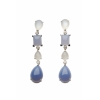|
 Chalcedony
is a collective name used to denote many well known varieties of cryptocrystalline
quartz gemstones, therefore the name «the mother of crystal». Chalcedony
includes carnelian, sard, bloodstone, onyx, sardonyx, chrysoprase, agate,
flint, chert and jasper just to name a few of the better known varieties. Chalcedony
is a collective name used to denote many well known varieties of cryptocrystalline
quartz gemstones, therefore the name «the mother of crystal». Chalcedony
includes carnelian, sard, bloodstone, onyx, sardonyx, chrysoprase, agate,
flint, chert and jasper just to name a few of the better known varieties.
Because of
its abundance, durability, and beauty, chalcedony was, except for sticks, animal
skins, bones, and plain rocks, the earliest raw material used by humankind. The
earliest recorded use of chalcedony was for projectile points, knives, tools,
and containers such as cups and bowls. It is believed that the gemstone was
named after the ancient port city of Chalcedon, on the Asia Minor side of the
Bosporus. Chalcedony is mentioned in the New Testament (Revelations 21:19) as one
of the twelve gemstones set in the foundations of the city walls of Jerusalem. According
to the legend, foundations of the city walls are decorated with various gemstones:
jasper, sapphire, chalcedony, emerald, sardonyx, carnelian, chrysolite, beryl, topaz,
chrysoprase, hyacinth, and amethyst. One of the earliest writers tied the
Apostles with the symbolism of the twelve gems of Jerusalem, and chalcedony
represented the Apostle St. Andrew.
Chalcedony has
a waxy luster and appears in a great variety of colors including blue, white,
buff, tan, green, red, grey, black, yellow or brown. Different colored
varieties of chalcedony have individual names including agate (banded),
bloodstone (green with red spots), chalcedony (blue to brownish blue),
chrysoprase (apple green), carnelian (orange to red), flint (dull grey to
black), jasper (spotted red, yellow, brown or green) and sard (light to dark
brown). The agate is most varied and popular of all chalcedonies. It is
extremely abundant and creates unusual and stunning examples. Most agate is
ugly in a natural state. Specimens must be trimmed and polished to bring out
their full beauty. Most specimens sold to collectors have already been treated,
in the form of tumbled stones or polished slabs.
Many past
cultures chose chalcedonies as the medium from which to craft their amulets.
Created by temple priests, amulets were worn for any variety of reason, such as
to secure public favor, ensure victories, keep a lover faithful, keep one safe
on a journey, or protect the wearer from political upheaval or war. Greek
seafarers in the third or fourth century AD wore chalcedony and 'carbuncle'
(probably garnet) amulets to avoid drowning. The Romans prized chalcedony as
seals, and astrologers of the Middle Ages wore engraved signet rings of
chalcedony as amulets. During the Renaissance, chalcedony was used as a magic
amulet to promote health and safety.
Chalcedonies
are used to create figurines, fine gifts, vases, dishes, tiles, furniture
inlays, various interior decoration accents, as the reasonable price of the
gems promotes their wide application.
Some of
chalcedony varieties are used in the manufacture of tiles for bathrooms, saunas
and luxury baths. It is believed that chalcedony-based tiles help the improve
air conditioning in the room. Also, stained glass and lampshades are made of
another chalcedony variety, onyx, using the Tiffany technique. Also a favored
architectural facing material, chalcedony has been extensively used in the
interiors of many of Europe's architectural «jewels.» One such jewel is the
Usimbardi Chapel, built in Florence, Italy (therefore the name «florentine
mosaic»).
In Europe, the
oldest agate deposits were near Idar-Oberstien, Germany, where agate geodes of
unique habit were found. Unfortunately, that deposit has long since been worked
out.
Chalcedony
varieties are extensively used in litotherapy. For instance, white chalcedony
improves vision, and sard, when placed on the wounds and ulcers, promotes their
healing. In addition, sard promotes fertility, but one should distinguish
between «female» (bright) and «male» (dark) gemstones. Sardonyx aides speedy bone
union and stops bleeding. Onyx enhances memory, and, when set in silver, helps
with heart aches and insomnia. Banded onyx is believed to have miraculous painkilling
properties - it was applied to the areas of inflammation, tumors and on the belly
in case of abdominal cramps. Agate treats diseases of the throat and teeth,
gout and cramps.
Virtually
any chalcedony variety is an excellent remedy for nervous exhaustion and
stress, but wearing chalcedony jewelry around the clock is not recommended, as its
lasting effect on the nervous system may give rise to unreasonable fears and
anxiety.
Numerous
magical properties are attributed to chalcedony. The gem is believed to possess
feminine character and stimulate the lust for life, love and happiness.
Therefore, various amulets designed to banish sadness and bring joy have been
made with chalcedony. To this day, lucky charms and talismans incorporating
chalcedony are produced, which should shoo away evil spirits and protect from
nightmares.
|